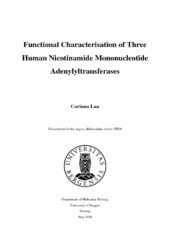| dc.description.abstract | Nicotinamide adenine dinucleotide, NAD, is an essential redox factor in many, primarily catabolic, hydrogen transfer reactions. While the redox reactions are not accompanied by a net loss of the pyridine nucleotides, NAD+ is actively degraded in a variety of ADP-ribosyl transfer reactions which are implicated, for examples, in cellular stress responses, calcium signalling and genomic stability. Thus, a continuous biosynthesis of NAD is essential for cell viability and metabolism. The final step in NAD biosynthesis, the reversible transfer of the AMP moiety from ATP onto a pyridine mononucleotide (NMN or its acidic form) is catalysed by nicotinamide mononucleotide adenylyltransferases (NMNATs) and is common to both the de novo and the known salvage pathways. In humans, three NMNAT isoforms have been described and partially characterised. The present study was aimed at a comprehensive characterisation of the human NMNATs, in particular, with regard to isoform-specific functions in order to gain further insight into the cellular NAD homeostasis and its regulation. Kinetic studies revealed that NMNAT1 possesses the highest specific activity both in the forward and reverse reactions, while NMNAT3 exhibited the lowest substrate selectivity. Importantly, NMNAT3 readily used the reduced nicotinamide substrates (NMNH or NADH in the forward and reverse reaction, respectively) thereby indicating that besides NAD+, NADH may be directly formed from a reduced precursor. No significant inhibition by physiological intermediates including nucleotides and nucleosides as well as poly(ADPribose), PAR, was found. However, we observed a considerable activation, particularly of NMNAT2, by the green tea polyphenol epigallocatechin 3-gallate (EGCG). Investigations of the subcellular distribution established distinct localisations of the three NMNAT isoforms in the nucleus, the Golgi complex and the mitochondria. Structural analyses revealed that all human NMNATs have insertions in their primary structures which are absent from the bacterial counterparts. While in NMNAT1 this region of the protein contains a known nuclear localisation signal, we revealed a targeting function of a corresponding domain in NMNAT2. The stretch of amino acids 109-192 was shown to direct the protein to the Golgi complex. Deletion of this domain resulted in a catalytically active, cytosolic protein. Moreover, we demonstrated that cysteine palmitoylation within this targeting domain is essential to anchor NMNAT2 at the cytosolic surface of the Golgi complex. The isoform NMNAT1 is known to be targeted to the nucleus by a nuclear localisation signal, which we highlight to reside within the corresponding domain. An important additional function of this targeting domain in NMNAT1 was also established. We found that this region (amino acids 102-149) mediates a phosphorylation-dependent association with poly(ADP-ribosyl)ated PARP1 which substantially enhances the poly(ADPribosyl) ating activity of PARP1. Interestingly, the catalytic activation of PARP1 was independent of the ability of NMNAT1 to synthesise NAD, as revealed using a catalytically dead mutant of NMNAT1. Collectively, our results suggest that the inserts into the sequences of the human NMNATs mediate subcellular targeting and interactions with other cellular factors. Therefore, we propose to denote this region as isoform-specific targeting and interaction domain (ISTID). It will be important to establish this function also for the corresponding domain in the mitochondrial isoform, NMNAT3. Interestingly, its amino acid sequence indeed lacks a classical N-terminal targeting sequence implying another mode of mitochondrial import. | en_US |
